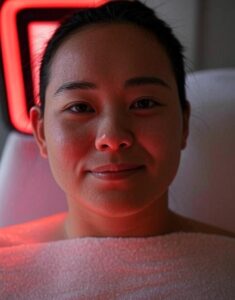 Red light therapy harnesses specific wavelengths to promote healing. This non-invasive treatment uses red and near-infrared light to penetrate the skin, stimulating cellular processes that enhance recovery and wellness. Scientists have studied its effects for decades, uncovering benefits like improved circulation, reduced inflammation, and better sleep. This article explores how this gentle therapy works and why it’s gaining popularity for those seeking natural health solutions.
Red light therapy harnesses specific wavelengths to promote healing. This non-invasive treatment uses red and near-infrared light to penetrate the skin, stimulating cellular processes that enhance recovery and wellness. Scientists have studied its effects for decades, uncovering benefits like improved circulation, reduced inflammation, and better sleep. This article explores how this gentle therapy works and why it’s gaining popularity for those seeking natural health solutions.
Light at specific wavelengths triggers remarkable changes in the body. Red light, typically between 620-700 nanometers, and near-infrared light, from 700-1100 nanometers, are key. These wavelengths drive photobiomodulation, a process where light energy boosts mitochondrial function. Mitochondria, the powerhouses of cells, produce more adenosine triphosphate (ATP), the energy currency that fuels repair and regeneration. This process enhances blood flow and reduces oxidative stress, laying the foundation for healing.
Looking to have a better sleep? Check out the Helios Red Light Therapy Bed listed on the Solbasium platform.
How Red Light Therapy Speeds Up Healing
Injuries heal faster when circulation improves. Red light therapy dilates blood vessels, increasing oxygen and nutrient delivery to damaged tissues. Studies show it can reduce recovery time for wounds, muscle strains, and even surgical incisions. For athletes, this means quicker return to training. For everyday folks, it translates to less downtime after minor injuries.
Inflammation doesn’t stand a chance against this therapy. Chronic inflammation underlies many health issues, from arthritis to skin conditions. Red light reduces pro-inflammatory cytokines, calming the body’s overactive immune response. A 2017 study in Lasers in Medical Science found that red light therapy significantly reduced inflammation in patients with joint pain, offering relief without side effects.
Collagen production gets a boost, too. Skin health improves as red light stimulates fibroblasts, the cells responsible for collagen synthesis. This leads to faster wound closure and smoother, healthier skin. “I noticed my scars fading after just a few sessions,” says Lisa, a 34-year-old who used red light therapy post-surgery. Whether for acne scars or stretch marks, the results are often visible and lasting.
Better Sleep Through Light
Sleep quality improves with red light therapy. Exposure to red and near-infrared light regulates melatonin production, the hormone that governs sleep. Unlike blue light from screens, which disrupts circadian rhythms, red light has a calming effect. A 2019 study in Journal of Clinical Sleep Medicine showed that participants using red light therapy fell asleep faster and reported deeper rest.
Stress reduction plays a role in better rest. Red light therapy lowers cortisol levels, the stress hormone that keeps you awake at night. By promoting relaxation, it creates the perfect conditions for sleep. Imagine drifting off effortlessly, waking refreshed, all thanks to a few minutes of gentle light exposure before bed.
READ ALSO: Sleep for Healthy Lifestyle
Additional Benefits of Red Light Therapy
The benefits extend beyond healing and sleep. This therapy offers a range of advantages that enhance overall wellness. Here’s a quick look at what it can do:
- Improved mood: By reducing stress and balancing hormones, red light therapy can lift your spirits.
- Enhanced muscle recovery: Athletes use it to reduce soreness and improve performance.
- Better skin tone: It reduces wrinkles and evens out complexion for a youthful glow.
- Pain relief: Conditions like fibromyalgia and chronic back pain respond well to regular sessions.
How to Use Red Light Therapy
Using red light therapy is simple and safe. Devices range from handheld wands to full-body panels, like those offered by Helios. Sessions typically last 10-20 minutes, 3-5 times a week. Position the device a few inches from the skin, targeting the area of concern, whether it’s a sore muscle or your face for anti-aging benefits.
Consistency is key to seeing results. While some notice changes within days, most benefits build over weeks. “It’s like watering a plant,” says Dr. Jane Carter, a wellness expert. “Regular care yields the best growth.” Always follow device instructions and consult a healthcare provider if you have underlying conditions.
Why Choose Red Light Therapy?
This therapy is backed by science and user experiences. Its non-invasive nature makes it appealing for those avoiding medications or invasive treatments. With no downtime and minimal risks, it’s a versatile tool for wellness. Whether you’re an athlete recovering from a marathon or someone struggling with sleepless nights, red light therapy offers a gentle, effective solution.
The future of wellness looks literally bright. As research continues, the applications of photobiomodulation expand. From hospitals to home spas, red light therapy is transforming how we heal and rest. Why not give it a try? Your body and mind might thank you with faster recovery and sweeter dreams.
